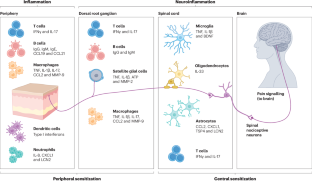Pain in systemic lupus erythematosus: emerging insights and paradigms
IF 32.7
1区 医学
Q1 RHEUMATOLOGY
引用次数: 0
Abstract
Systemic lupus erythematosus (SLE) is a chronic autoimmune disease characterized by protean clinical manifestations that are associated with immune system dysregulation. Of these manifestations, pain and pain-related symptoms such as fatigue, mood disturbance and cognitive impairment are the most common features reported by patients and represent important determinants of quality of life. Nevertheless, the relationship of these symptoms to underlying immune mechanisms is unclear. To advance scientific study and patient-centric care, this Review will consider the origin of pain in SLE and the clinical ramifications. Although many of the inflammatory aspects of SLE, including arthritis, serositis and skin disease, can be associated with nociceptive pain, patients frequently report pain that seems out of proportion to the degree of inflammation. In many of these patients, pain might reflect central and peripheral nervous system sensitization that mediates nociplasticity, a change in brain processing; with nociplasticity, changes in neuronal function and brain connections can amplify the experience of pain and pain-related symptoms. The close interplay between the immune and the nervous systems means that widespread pain and the associated symptoms can be considered as essential features of SLE; these features might share pathogenic mechanisms with other autoimmune diseases and nociplastic pain syndromes such as fibromyalgia. In systemic lupus erythematosus (SLE), pain is one of the most commonly reported and debilitating symptoms. The authors of this Review highlight the importance of understanding the mechanisms of pain in SLE and addressing pain and pain-associated symptoms in the management of SLE.


系统性红斑狼疮疼痛:新出现的见解和范例
系统性红斑狼疮(SLE)是一种慢性自身免疫性疾病,其特点是临床表现多样,与免疫系统失调有关。在这些表现中,疼痛和疼痛相关症状,如疲劳、情绪障碍和认知障碍是患者报告的最常见特征,也是影响生活质量的重要因素。然而,这些症状与潜在免疫机制的关系尚不清楚。为了推进科学研究和以患者为中心的护理,本综述将考虑SLE疼痛的起源和临床后果。尽管SLE的许多炎症方面,包括关节炎、浆液炎和皮肤病,都可能与痛觉性疼痛有关,但患者经常报告的疼痛似乎与炎症程度不成比例。在这些患者中,疼痛可能反映了中枢和周围神经系统的致敏,介导了大脑处理的一种变化;在疼痛可塑性中,神经元功能和大脑连接的变化可以放大疼痛体验和疼痛相关症状。免疫系统和神经系统之间的密切相互作用意味着广泛的疼痛和相关症状可以被认为是SLE的基本特征;这些特征可能与其他自身免疫性疾病和伤害性疼痛综合征(如纤维肌痛)的致病机制相同。
本文章由计算机程序翻译,如有差异,请以英文原文为准。
求助全文
约1分钟内获得全文
求助全文
来源期刊

Nature Reviews Rheumatology
医学-风湿病学
CiteScore
29.90
自引率
0.90%
发文量
137
审稿时长
6-12 weeks
期刊介绍:
Nature Reviews Rheumatology is part of the Nature Reviews portfolio of journals. The journal scope covers the entire spectrum of rheumatology research. We ensure that our articles are accessible to the widest possible audience.
 求助内容:
求助内容: 应助结果提醒方式:
应助结果提醒方式:


